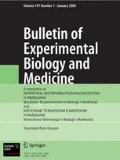Summary
The relationship of anticoagulant heparin was investigated with thrombotropin, prothrombokinase, thrombokinase and calcium.
It was demonstrated that heparin and thrombotropin are in antagonistic relationship.
Prothrombokinase and thrombokinase reduce the activity of heparin to the same extent.
Calcium chloride greatly decreases the activity of heparin introduced into the bloodstream.
Heparin introduced into the blood has no effect on the concentration of calcium salts in the blood.
The author considers that heparin exeris a powerful anticoagulant effect with compound action only in a pathological condition of the body when thrombogenic components which may directly cause the intravascular blood coagulation enter the bloodstream.
Similar content being viewed by others
Literature Cited
G. V. Andreenko, Dokiady Akad. Nauk SSSR, 11, No. 6, 1948.
G. V. Andreenko, Doklady Akad. Nauk SSSR, 108, No. 5 (1956). Original Russian pagination See C. B. Translation.
P. P. Astanin, Practical Course of Biochemistry, Agricultural Press, 1951. In Russian.
B. A. Kudryashov, Doklady Akad. Nauk SSSR. 10, No. 8, 1948.
B. A. Kudryashov, P. D. Ulitina and A. L. Pugacheva, Byull. Eksptl. Biol. J Med., No. 11, p. 99, 1941.
M. A. Ukolova, Proceeding VIII. Congress of Physiologists, Biochemists and Pharmacologists, pp. 156–157, Voreonezh, 1948. In Russian.
M. A. Ukolova, Proceedings All-Union Congress of Physiologists, Biochemists, and Pharmacologists, p. 621, 1955. In Russian.
C. L. Conley and R. C. Hartmann, Proc. Soc. exp. Biol. Med., 1948, v. 69, N. 2, p. 284.
H. E. Dale, Pharm. J., 1953, 4682, 67.
E. Donzelot and H. Kaufmann, Presse med., 1952, v. 78, No. 16, p. 19.
A. Fischer and T. Astrup, Biochem. Z., 1935, 278, 326.
J. W. Lyttleton, Biochem. J., 1954, 58, 1, 8.
K. Lenggenhager, Helv. med. Acta, 1953, v. 10, 527.
R. Marbot and A. Winterstein, Helv. Phys. pharm. acta. 1952, 10, 4, 528.
A. J. Quick, Am. J. Phys., 1949, 158, 387.
A. J. Quick, The Physiology and Pathology of Hemastasis, Ph. D. M. D., 1951.
Additional information
From the Laboratory (Director: Prof. B. A. Kudryashov). Chair of Biochemistry of Animals, Faculty of Biology and Soil Science, MGU
Rights and permissions
About this article
Cite this article
Leikina, E.M. Significance of heparin in the process of blood coagulation. Bull Exp Biol Med 44, 1025–1028 (1957). https://doi.org/10.1007/BF01306820
Received:
Issue Date:
DOI: https://doi.org/10.1007/BF01306820



